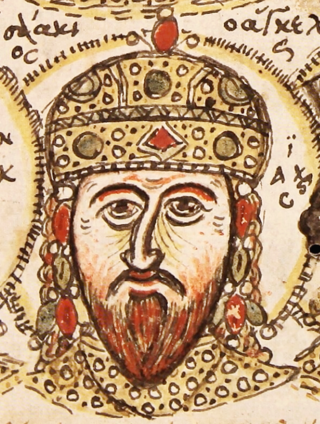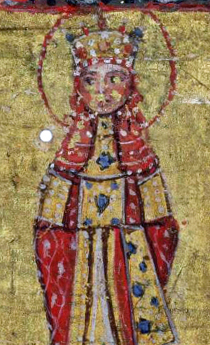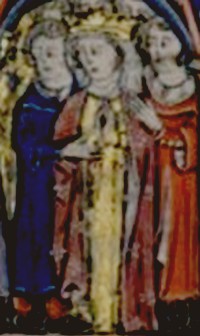
Alexios II Komnenos, Latinized Alexius II Comnenus, was Byzantine emperor from 1180 to 1183. He ascended to the throne as a minor. For the duration of his short reign, the imperial power was de facto held by regents.

Alexios III Angelos, Latinized as Alexius III Angelus, was Byzantine Emperor from March 1195 to 17/18 July 1203. He reigned under the name Alexios Komnenos, associating himself with the Komnenos dynasty. A member of the extended imperial family, Alexios came to the throne after deposing, blinding and imprisoning his younger brother Isaac II Angelos. The most significant event of his reign was the attack of the Fourth Crusade on Constantinople in 1203, on behalf of Alexios IV Angelos. Alexios III took over the defence of the city, which he mismanaged, and then fled the city at night with one of his three daughters. From Adrianople, and then Mosynopolis, he attempted unsuccessfully to rally his supporters, only to end up a captive of Marquis Boniface of Montferrat. He was ransomed and sent to Asia Minor where he plotted against his son-in-law Theodore I Laskaris, but was eventually captured and spent his last days confined to the Monastery of Hyakinthos in Nicaea, where he died.

Andronikos I Komnenos, Latinized as Andronicus I Comnenus, was Byzantine emperor from 1183 to 1185. He was the son of Isaac Komnenos and the grandson of the emperor Alexios I. In later Byzantine historiography, Andronikos I became known under the epithet "Misophaes" in reference to the great number of enemies he had blinded.
The 1180s was a decade of the Julian Calendar which began on January 1, 1180, and ended on December 31, 1189.

Year 1180 (MCLXXX) was a leap year starting on Tuesday of the Julian calendar.

Year 1182 (MCLXXXII) was a common year starting on Friday of the Julian calendar.

Year 1185 (MCLXXXV) was a common year starting on Tuesday of the Julian calendar.

Isaac II Angelos or Angelus was Byzantine Emperor from 1185 to 1195, and again from 1203 to 1204.

Isaac Doukas Komnenos was a claimant to the Byzantine Empire and the ruler of Cyprus from 1184 to 1191. Contemporary sources commonly refer to him as the emperor of Cyprus. He lost the island to King Richard I of England during the Third Crusade.
The House of Komnenos, Latinized as Comnenus, was a Byzantine Greek noble family who ruled the Byzantine Empire in the 11th and 12th centuries. The first reigning member, Isaac I Komnenos, ruled from 1057 to 1059. The family returned to power under Alexios I Komnenos in 1081 who established their rule for the following 104 years until it ended with Andronikos I Komnenos in 1185. In the 13th century, they founded and ruled the Empire of Trebizond, a Byzantine rump state from 1204 to 1461. At that time, they were commonly referred to as Grand Komnenoi, a style that was officially adopted and used by George Komnenos and his successors. Through intermarriages with other noble families, notably the Doukas, Angelos, and Palaiologos, the Komnenos name appears among most of the major noble houses of the late Byzantine world.

Maria of Antioch (1145–1182) was a Byzantine empress by marriage to Byzantine Emperor Manuel I Komnenos, and regent during the minority of her son porphyrogennetos Alexios II Komnenos from 1180 until 1182.

Agnes of France, renamed Anna, was Byzantine Empress by marriage to Alexios II Komnenos and Andronikos I Komnenos. She was a daughter of Louis VII of France and Adèle of Champagne.

Theodora Komnene or Comnena was a niece of Byzantine emperor Manuel I Comnenus, and wife of King Baldwin III of Jerusalem.
Renier of Montferrat (1162–1183) was the fifth son of William V of Montferrat and Judith of Babenberg. He became son-in-law of the Byzantine Emperor Manuel I Komnenos and Caesar in 1180, and was later murdered in a Byzantine power-struggle.
AlexiosBranas or Vranas was a Byzantine nobleman, attempted usurper, and the last Byzantine military leader of the 12th century to gain a notable success against a foreign enemy.
The House of Angelos, feminine form Angelina (Ἀγγελίνα), plural Angeloi (Ἄγγελοι), was a Byzantine Greek noble lineage which rose to prominence through the marriage of its founder, Constantine Angelos, with Theodora Komnene, the youngest daughter of Emperor Alexios I Komnenos. As imperial relatives, the Angeloi held various high titles and military commands under Emperor Manuel I Komnenos. In 1185, following a revolt against Andronikos I Komnenos, Isaac II Angelos rose to the throne, the first of three Angeloi emperors who ruled until 1204. The period was marked by the decline and fragmentation of the Byzantine Empire, culminating in its dissolution by the Fourth Crusade in 1204.

The Byzantine Empire was ruled by emperors of the Komnenos dynasty for a period of 104 years, from 1081 to about 1185. The Komnenian period comprises the reigns of five emperors, Alexios I, John II, Manuel I, Alexios II and Andronikos I. It was a period of sustained, though ultimately incomplete, restoration of the military, territorial, economic and political position of the Byzantine Empire.

The Byzantine Empire was ruled by emperors of the Angelos dynasty between 1185 and 1204 AD. The Angeloi rose to the throne following the deposition of Andronikos I Komnenos, the last male-line Komnenos to rise to the throne. The Angeloi were female-line descendants of the previous dynasty. While in power, the Angeloi were unable to stop the invasions of the Turks by the Sultanate of Rum, the uprising and resurrection of the Bulgarian Empire, and the loss of the Dalmatian coast and much of the Balkan areas won by Manuel I Komnenos to the Kingdom of Hungary.
Andronikos Komnenos Kontostephanos, Latinized Andronicus Contostephanus, was a major figure in the Eastern Roman Empire during the reign of his uncle Manuel I Komnenos as a general, admiral, politician and a leading aristocrat.
Constantine Komnenos Angelos was a Byzantine aristocrat and military commander, and the older brother of the emperors Isaac II Angelos and Alexios III Angelos. He was blinded by the usurper Andronikos I Komnenos, and raised to sebastokrator by his brother Isaac upon the latter's accession to the throne in 1185.












